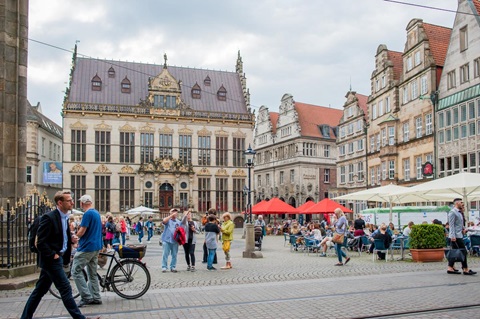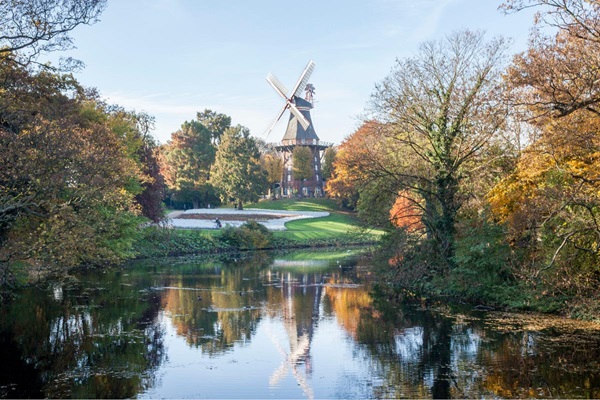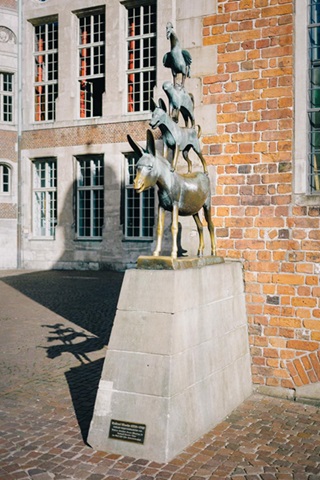
Historic Hanseatic City of Bremen – A look at history
780 - First documented mention
Charlemagne sends the Anglo-Saxon missionary Willehad to Bremen. Bremen is first documented in 782. Willehad is appointed bishop in 787, making Bremen an episcopal see.
1035 - Ischa Freimaak
Bremen is granted the right by Emperor Conrad II to hold a free market in the spring and fall, where anyone can offer their goods. The fall market has survived to this day, the Freimarkt.

1303 - Bremen Statutes
Bremen's first city charter, the "Statuten", is written down.
1350 - Plague
The plague rages in Bremen. With almost 7,000 deaths, the city loses about a third of its population.
1358 - Hanseatic League
Membership in the Hanseatic League ensures flourishing trade with Flanders, England and Scandinavia. Bremen's merchants gain economic and political power.
1404/1405 - Bremen Roland and Town Hall
The wooden Roland, which burned down in 1366, is replaced by the stone Roland, which has since become a symbol of Bremen's freedom. One year later, in 1405, the foundation stone for Bremen's town hall is laid on the market square.
Bremen Statutes 1600 - Heyday
The economic and cultural heyday is reflected in Bremen's cityscape: the Schütting (the building of the Bremen merchants, formerly the merchants' guild and boarding house), the city scales and the façade of the Weser Renaissance town hall are built.

1646 - Free Imperial City
Bremen is recognized as a Free Imperial City in the Linz Diploma. The imperial immediacy frees Bremen from the pressure of a direct sovereign and gives the city a high degree of freedom of movement, especially in times of peace, which benefits Bremen's trade and shipping.
1802 - The ramparts
The ramparts and bastions of the fortress are demolished and replaced by today's ramparts.
1806 - Free Hanseatic City
With the dissolution of the Holy Roman Empire, Bremen becomes an independent and sovereign free city and is named the Free Hanseatic City.
1810 - French occupation
Bremen is incorporated into the French Empire and becomes the capital of the "Département des Etuis de la Weser". Three years later, after liberation from French troops, the Bremen system of government and the old constitution are restored.

1926 - Böttcherstrasse
Inauguration of the famous Böttcherstrasse, a 108-meter-long street in Bremen's Old Town, whose architecture makes it one of Bremen's cultural monuments and tourist attractions.
1827 - Bremerhaven
Bremen acquires from Hannover an area on the north bank of the Geeste estuary, now known as Bremerhaven, in order to create a port suitable for seagoing vessels. This creates the first structures of the state of Bremen.
1934 - Loss of independence
Parliament is dissolved by the Nazi government. The state of Bremen loses its independence and is incorporated into the Weser-Ems-Gau.

1939-1945 - Second World War
Large parts of the city, almost all the ports, are destroyed by a total of 173 air raids during the Second World War. The heaviest attack, on August 18 and 19, 1944, killed more than 1,000 people.
1945 - Reconstruction
The U.S. military government appoints Wilhelm Kaisen (SPD) as mayor and president of the Bremen Senate. In this position, he guides the city's reconstruction for the next 20 years.
1947 - Independence restored
The new state constitution is proclaimed on October 21: Bremen is an independent state in the American occupation zone and consists of the cities of Bremen and Bremerhaven.
1953 - Bremen Town Musicians
The bronze statue of the Bremen Town Musicians by Gerhard Marcks is erected. It is probably the city's best-known landmark and recalls the popular fairy tale by the Brothers Grimm, in which a donkey, a dog, a cat, and a rooster set out for the city on the Weser River to find a better life.

1971 - University of Bremen
The University of Bremen opens its doors.
1982 – Hochschule Bremen
HSB Hochschule Bremen – City University of Applied Sciences is founded, to which IGC belongs. It is a merger of the former University of Economics, the University of Technology, the University of Social Pedagogy and Social Economics, and the University of Nautics.
1998 - Überseestadt
The filling in and development of the Überseehafen basin marks the beginning of the transformation of the port area into a modern urban district, Überseestadt. The 300-hectare area is one of the largest urban development projects in Europe and has become a lively and innovative district.
2004 - UNESCO World Heritage
The Bremen Town Hall, one of the most important buildings of the Brick Gothic and Weser Renaissance periods in Europe, and the Roland statue on the market square, a symbol of the city's independence, are inscribed on the UNESCO World Heritage List.
Find out more about Bremen as a business location - the major companies in the Hanseatic city
